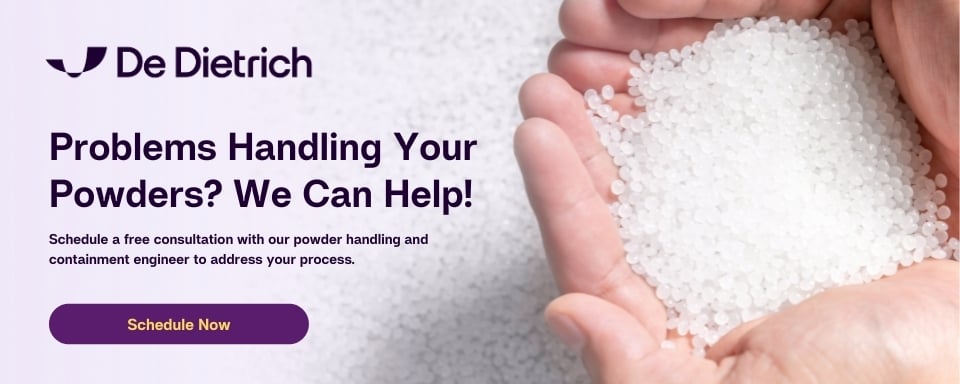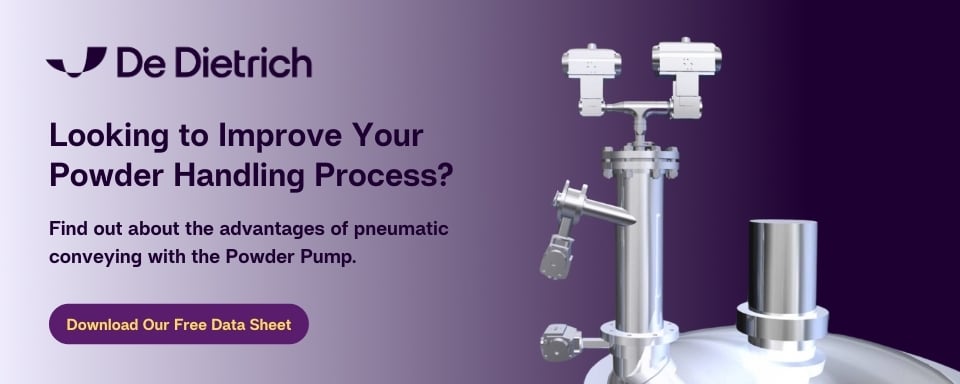Why Test the Pneumatic Transfer Properties of Your Powder?

Most people see the practicality in testing a product before fully investing and entering a long-term commitment. Rarely does a person purchase a new car without first taking it for a test drive to see if he/she likes the feel of it prior to signing the ownership papers and handing over a hefty down payment.
When it comes to systems specifically designed to transfer powder, you definitely want to make sure your material is going to move from “point A” to “point B” before you purchase and install an expensive piece of equipment in your facility.
There are some instances where testing simply isn’t possible, but when it is, it may save you a lot of future hassle and grief, as well as give you total confidence that your project is going to be a success. (Trust me, there is no feeling like pressing the start button on a new installation for the first time with the new owners / operators watching to see if your equipment works if no testing has been conducted. Talk about stressful!) So when you do have the chance to test out prospective equipment it is definitely worth taking advantage of the opportunity to fully ensure it will work the way you want it to.
After conducting the initial research on your end and narrowing down the equipment selections available to the one(s) you think will best suit your process requirements, it’s a good idea to find out what type of testing and/or product rental options are available. This will be especially helpful if you need to win over higher level management who have a “proof is in the pudding” methodology (and who can blame anyone faced with overseeing a large capital investment if they want some proof that the proposed idea will work?).
If no testing is possible but it’s a quality piece of equipment you feel strongly about, it’s important to obtain whatever data the manufacturer can provide to help assure it will effectively integrate into your process. If product testing is possible, then determining where the testing is conducted and what type of services the vendor can provide are among a few of the many questions you will want to ask.
Whether testing is available or not, you’ll want to supply the vendor with detailed information about your product to be transferred (see our Powder Handling Application Questionnaire as an example of the type of information a vendor will likely require). This will help the manufacturer assess potential difficulties that may present themselves prior to the actual test run, and to prequalify your product as a good candidate for the technology based on its characteristics, in combination with the objectives you are trying to achieve.
Along with the obvious advantage of seeing first-hand how well your product transfers, an additional benefit to conducting product testing is the opportunity it gives both you and the equipment manufacturer to develop new technical solutions to solve any potential problems that may present themselves during the testing phase. Overcoming hurdles you encounter early on will give you the assurance you need when making your ultimate decision to purchase the equipment.
Every application is unique in some way, so the ability to modify a process to create a customized solution can play a key role in your decision-making if in fact any customization is required to provide a solution to your process requirements. And what better guarantee is there than to have documented proof that the final system design will efficiently accomplish your powder handling objectives?
At De Dietrich Process Systems, we provide Powder Pump rental units for testing at your site, as well as in-house testing (on or off-site testing depends on your product physiognomies, among other factors).
In-house testing at our Charlotte, NC facility is conducted using QVF glass Powder Pump units. Testing with a glass unit gives you a unique perspective on what is going on inside the Powder Pump and allows us to observe the powder behavior and see how quickly the unit fills. The added visibility this provides helps us optimize your transfer settings and accurately determine:
- How fast and far the powder will move
- If there is a serious risk of plugging the transfer hose
- Where to set the initial cycle times
- Does the material blind the filter element quickly
- Does the filter media capture the particles efficiently
- How much gas pressure does it take to discharge the material
- Does the material discharge easily or bridge across the outlet valve
- Can the transfer hose be cleaned out easily
When we test at the customer’s site with our rental equipment (usually because the material is too toxic to easily transport and test at our facility), the customer learns about:
- All of the above (but not as easily as with the glass units, due to limited visibility)
- How the equipment is installed and operated
- Buy-in from operators who might benefit most from reduced PPE requirements or ergonomic improvements
- Improved safety and house-keeping by keeping material contained during transfer
Before you think about spending tens of thousands of dollars on a new piece of capital equipment (or hundreds of thousands on a new system), it helps if you know it is going to perform well. Product testing and “rent-to-own” options are two possible routes to help you make an educated decision before purchasing any powder transfer equipment.
The Powder Pump offers a simple, reliable way to pneumatically convey powders from one location to another. For more information about DDPS solutions that can meet the material handling challenges of your business, download our new Powder Handling Solutions Brochure, fill out this online form or contact brian.warren@ddpsinc.com.

